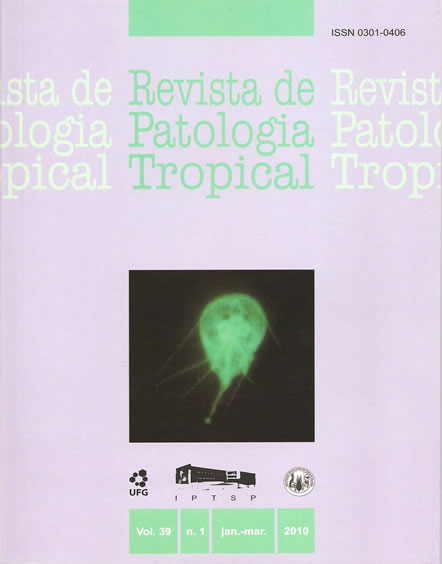Bovine viral diarrhea virus (BVDV) infection in Goiás, Brazil.
DOI:
https://doi.org/10.5216/rpt.v39i1.9494Keywords:
Bovine viral diarrhea virus, Goiás, Epidemiology, Prevalence, Risk factors.Abstract
This study was performed to estimate the seroprevalence of bovine viral diarrheavirus (BVDV) in a population of non-vaccinated cattle in Goiás State, Brazil, and
to determine the potential risk factors related to the seropositivity. Serum samples
were collected from 3,533 animals of 888 herds from 232 municipalities in Goiás
between March and September, 2002. These samples were submitted to the serum
neutralization test and an epidemiological questionnaire was filled out for each
herd to investigate variables that could be associated with this infection. The data
were analyzed using Epi Info 6.04. In addition, 960 BVDV antibody-negative
sera were further tested by antigen-ELISA in order to identify persistently infected
animals (PI). The seroprevalence was 64.0% and 784 (88.3%) herds had at least
one seropositive animal. Two hundred and twenty six (97.4%) municipalities
showed at least one positive herd/animal. Only age influenced the presence of
neutralizing antibodies to this virus in animals. None of the exposure variables
analyzed was considered as a risk factor for the infection with BVDV in cattle
herds. Four (0.4%) of 960 seronegative samples were BVDV antigen positive. Based on these results, we concluded that BVDV infection is spread among cattle
herds in Goiás State, Brazil.
Downloads
Downloads
Published
How to Cite
Issue
Section
License
The manuscript submission must be accompanied by a letter signed by all authors stating the full name and email address, confirming that the material has not been published or is under consideration for publication elsewhere, and agreeing to transfer copyright in all media and formats for Journal of Tropical Pathology. The authors will not be paid for published articles. They are solely responsible for the content of those articles, even if the Editor holds the right to adjust them to the norms of the journal.
The reviewers will not be paid for the peer review process.

